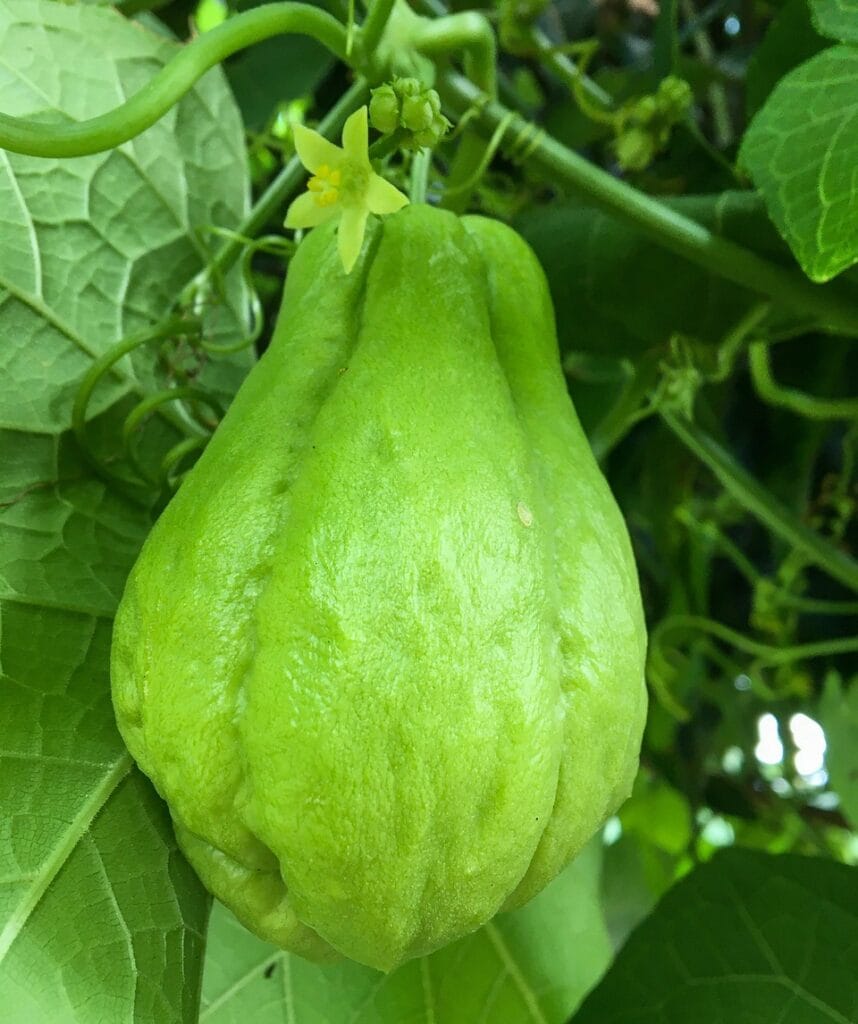Discovering Chayote
Every time we reflect on our diet and think about improving it, certain foods quickly come to mind. Usually, quinoa, chia, or kale take center stage in our thoughts. However, surprisingly enough, it’s likely that in our own kitchen there’s a vegetable just as—if not more—beneficial. This somewhat overlooked vegetable is chayote.
Chayote, scientifically known as Sechium edule, thrives in temperate, sunny climates and in soils that allow water to drain easily (SADR, 2024).

The chayote’s place of origin stretches from central Mexico down through the countries of Central America (SADR, 2021). Today, however, it is cultivated and found in many parts of the world (Hill, 2023). And across the globe, you’ll encounter it under a variety of different names (Table 1).
| Región | Nombres |
|---|---|
| Mexico | Chayote |
| United States | Mirliton, Chayote Squash |
| United Kingdom | Christophine, Cho Cho Pear |
| Australia | Choko, Mirliton |
| Francophone Countries | Christophine |
| Brazil | Chuchu |
| Honduras | Pataste |
| Jamaica | Cho cho |
| Colombia | Guatila |
| Argentina | Papa de Aire |
| Guatemala | Guisquil |
| Philippines | Sayote |
| India | Chow-chow |
In this article, you’ll discover seven properties that explain why chayote can be considered an extraordinary hidden superfood.

1. Low in Calories and High in Water
When it comes to weight loss, chayote is a perfect ally. It allows you to consume fewer calories while still nourishing your body properly. This is because this vegetable contains a lot of water and only about 40 calories per 100-gram serving (Hill, 2023; Shamirian, 2024). This places chayote among light and hydrating foods. Additionally, it helps you feel full without consuming excess energy that cannot be expended. If one isn’t careful, any surplus energy can eventually lead to weight gain (Romieu et al., 2017).
These characteristics—water + volume = satiety—make chayote an excellent side dish for meals. In this sense, it can replace potatoes and pasta as a lower-calorie option with good proportions, unexpectedly demonstrating that even a seemingly simple food can be valuable within a balanced diet.

2. High in Dietary Fiber
Chayote helps maintain the proper functioning of our digestive system thanks to its notable fiber content. In fact, a piece of approximately 200 grams can provide about 4 grams of fiber (Tua Saúde, 2025). What does this tell us? In short, a single chayote satisfies just over 10% of our daily fiber needs.
Moreover, another interesting benefit of fiber is its role in regulating blood glucose. It achieves this by slowing the absorption of sugars, which also helps maintain steady energy levels throughout the day. Additionally, fiber promotes satiety, making it an excellent support for those looking to maintain or achieve a moderate caloric intake (Ignite Healthwise, 2024).

3. A Remarkable Source of Folate
Chayote stands out for its folate content, also known as vitamin B9. A single serving can provide nearly half of the recommended daily intake of this nutrient. In fact, folate is essential for the formation of new cells and the proper development of tissues (Hill, 2023).
Even during pregnancy, folate plays a crucial role, as it helps prevent developmental malformations in the embryo. Additionally, it supports maternal health (Fischer, 2022). For these reasons, chayote is a valuable food during periods of growth and pregnancy.

4. Rich in Vitamin C and Antioxidants
Vitamin C is an important component among the nutrients found in chayote. Still, if you take a bite, you won’t notice the sour taste of a lemon. Yet within it lies about 25% of the daily requirement for this nutrient (Hughes, 2018). Vitamin C provides chayote with its immune-boosting benefits and its antioxidant power. This antioxidant effect acts like a small protective shield against the impact of free radicals.
However, vitamin C does not work alone in chayote. It is accompanied by flavonoids and polyphenols—two compounds that further enhance its antioxidant effect.
As a result, regular consumption of chayote may be linked to an overall improvement in health, all thanks to this unique combination of micronutrients (LeBrun, 2024).

5. Chayote Supports Cardiovascular Health
If you want a healthy heart, you need to nourish it with healthy foods. That’s where chayote and its generous potassium content can give us a hand. This mineral is well known for its role in regulating blood pressure. Yet in chayote, potassium doesn’t work alone—it teams up with fiber and antioxidants, which we’ve already talked about (LeBrun, 2024).
To better understand how potassium does its job, let’s highlight two key points (AHA, 2024):
- Potassium counteracts the effects of sodium by helping the body flush it out through urine.
- It relaxes the walls of blood vessels, which lowers the pressure within them.
Thanks to these effects, chayote becomes a simple yet powerful way to support the health of our circulatory system. In this sense, a dish with chayote can be seen as a gesture of love for the heart (LeBrun, 2024).

6. Chayote Helps Regulate Blood Sugar
Among its many properties, one of the most remarkable is its ability to contribute to glucose regulation. This happens through the action of its fiber, its naturally low calorie content, and the synergy of its nutrients. Together, they help slow down and stabilize the absorption of sugars (Hill, 2023).
Therefore, including chayote in daily meals can benefit people dealing with blood sugar–related concerns. It offers them the chance to enjoy a tasty vegetable without much guilt.

7. A Light and Healthy Culinary Versatility
Our good friend, the chayote, is not only a nutritious vegetable but also a valuable ally in our daily health. Yet that’s not all—it is also a remarkably versatile ingredient in the kitchen. Its mild flavor and tender texture allow it to fit seamlessly into a wide range of dishes without overwhelming the palate. Whether raw or cooked, on its own or in salads, in soups or stews, it is simply delightful.
What can we eat from the chayote? Quite simply—everything!
Its leaves, seeds, and roots are all edible, making it a whole-plant food. In this way, every part of the chayote can bring both flavor and nutrition into our lives (Shamirian, 2024).

Conclusion
Chayote has been present in family kitchens for centuries, especially in Mexico and Central America, its place of origin. Yet, its role as a superfood often goes unnoticed compared to more heavily promoted options. This humble, accessible, and abundant vegetable brings together nutritional qualities that truly make it stand out—particularly for those seeking to improve their health day by day.
Our friend, the chayote, is low in calories but rich in fiber. It is also packed with antioxidants, vitamins, and minerals, which translate into tangible benefits—mainly for digestion, cardiovascular health, and metabolic balance.
In the kitchen, chayote is a versatile ingredient that blends seamlessly into any dish of our daily diet. Regardless of our life stage, age, or eating style, chayote always finds a way to contribute both flavor and texture. Personally, I prefer mature or firm chayotes, simply boiled with a pinch of salt. To me, they are truly delicious and bring back fond memories of my childhood.
For all these reasons and more, discovering and valuing chayote is an act of justice toward this humble food. It is also a reminder that true nutritional treasures do not always come from afar—sometimes they are closer than we think. They are waiting to be rediscovered at the local market or the corner shop. Including it in your meals can be a simple yet powerful step toward more mindful well-being.


